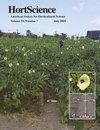在受控温室条件下柑橘种质幼苗对亚洲自由杆菌感染的反应
IF 1.5
3区 农林科学
Q2 HORTICULTURE
引用次数: 0
摘要
黄龙病(HLB)是柑橘的一种主要病害,与韧皮部局限性细菌(Candidatus Liberibacter)属有关,影响所有已知的柑橘品种和近缘品种,许多商业栽培品种受到严重损害。在田间条件下测试栽培品种对 HLB 的耐受性非常困难,因为细菌的传播、接穗和砧木之间的相互作用以及许多生物和非生物因素对果树对该病的反应都有影响。本研究的目的是在受控温室条件下,利用 CLas 嫁接接种验证 CLas 感染对不同柑橘品种和杂交种的影响,这些品种和杂交种被认为对该病有不同程度的耐受性。对 12 种不同柑橘种质选育的盆栽幼苗进行了 CLas 嫁接接种或模拟接种。在 18 个月内定期监测植株的冠层生长、HLB 和营养叶症状以及叶片 CLas 滴度。实验结束时测量叶片养分含量。在接种后 18 个月(mai),还对根部的 CLas 滴度和生物量分布进行了评估。健康植株和受感染植株的大多数分析变量都存在明显差异。所有栽培品种中都有一些植株成功感染了CLas,但总体而言,CLas的传播率较低且不稳定。18 mai 时,根部的 Ct 值普遍高于叶片。幼苗在接种后 1 年才出现 HLB 症状;在 18 mai 时,所有栽培品种的受感染树木都出现了 HLB 症状。受感染的'Cleopatra'、'Duncan'、'Olinda Valencia'、'Sunburst'和'Valencia 1-14-19'被认为对 HLB 易感,测量结果表明,它们的嫩枝和根部生物量显著减少(44%-75%)。这些栽培品种也比小柑橘、Rich 16-6 三叶橙和 US-897 等假定耐受 HLB 的栽培品种表现出更严重的 HLB 症状。这项研究为温室筛选柑橘种质对 HLB 的反应的有效性和价值提供了新的知识,有助于开发具有更好的 HLB 耐受性或抗性的新栽培品种。本文章由计算机程序翻译,如有差异,请以英文原文为准。
Response of Citrus Germplasm Seedlings to Candidatus Liberibacter Asiaticus Infection under Controlled Greenhouse Conditions
Huanglongbing (HLB) is a major disease of citrus associated with phloem-limited bacteria in the genus Candidatus Liberibacter that affects all known citrus species and relatives, with many commercial cultivars being greatly damaged. Testing cultivar tolerance to HLB in field conditions is difficult because of the erratic spread of the bacteria, scion and rootstock interactions, and influence of many biotic and abiotic factors on the tree response to the disease. This study aimed to validate the effect of CLas infection on different citrus species and hybrids thought to have different levels of tolerance to the disease using CLas graft inoculation under controlled greenhouse conditions. Young potted seedlings from 12 different citrus germplasm selections were graft-inoculated with CLas or mock-inoculated. Plants were monitored periodically during 18 months for canopy growth, HLB and nutritional leaf symptoms, and leaf CLas titers. The leaf nutrient content was measured at the end of the experiment. Roots were also assessed at 18 months after inoculation (mai) for CLas titers and biomass distribution. There were significant differences in most analyzed variables of healthy and infected plants. Some plants of all cultivars were successfully infected; however, overall, the CLas transmission rate was low and inconsistent. Ct values of roots were generally higher than those in leaves at 18 mai. HLB symptoms were not observed on seedlings until 1 year after inoculation; at 18 mai, infected trees of all cultivars were HLB symptomatic. Significant shoot and root biomass reductions (44%–75%) in infected ‘Cleopatra’, ‘Duncan’, ‘Olinda Valencia’, ‘Sunburst’, and ‘Valencia 1-14-19’, considered susceptible to HLB, were measured. These cultivars also showed more severe HLB symptoms than the presumed tolerant cultivars such as Microcitrus inodora, Rich 16-6 trifoliate orange, and US-897. This study provides new knowledge of the efficacy and value of greenhouse screening of citrus germplasm for response to HLB to support the development of new cultivars with improved HLB tolerance or resistance.
求助全文
通过发布文献求助,成功后即可免费获取论文全文。
去求助
来源期刊

Hortscience
农林科学-园艺
CiteScore
3.00
自引率
10.50%
发文量
224
审稿时长
3 months
期刊介绍:
HortScience publishes horticultural information of interest to a broad array of horticulturists. Its goals are to apprise horticultural scientists and others interested in horticulture of scientific and industry developments and of significant research, education, or extension findings or methods.
 求助内容:
求助内容: 应助结果提醒方式:
应助结果提醒方式:


